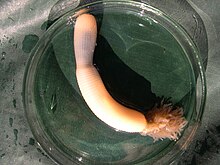Priapulida
| Priapulida Temporal range: Middle Cambrian to Recent
| |
|---|---|

| |
| Priapulus caudatus | |
| Scientific classification | |
| Kingdom: | |
| (unranked): | |
| Phylum: | Priapulida Théel, 1906
|
Priapulida (priapulid or penis worms)[1] are a phylum of marine worms. Their name refers to their extensible spiny proboscis, which, in some species, may have a shape similar to that of a human penis. They live in the mud, which they eat, in comparatively shallow waters up to 90 metres (300 ft).[2]
Their nearest relatives are probably Kinorhyncha and Loricifera with which they constitute the taxon Scalidophora. Besides arthropods and velvet worms, the priapulids are the only members of the Ecdysozoa which are relatively large in size. They feed on slow-moving invertebrates, such as polychaete worms.
Priapulid fossils are known at least as far back as the Middle Cambrian.[3] They were probably major predators of the Cambrian period. There are only sixteen known living species of priapulid worms.
There's a striking similarity between this word and Romanian "pula*( penis) which is similar in Spanish"pola" Now who's got it from who? Well, it's not "preapolid" to indicate a Spanish origin, but Romanian Compare it to another word" copulate*( to have sex) also with .pula' Constantine Cristin Quora
References[change | change source]
- ↑ from Gr. πριάπος, priāpos 'Priapus' + Lat. -ul-, diminutive
- ↑ Barnes, Robert D. 1982. Invertebrate zoology. Holt-Saunders, Philadelphia, PA. 873-877. ISBN 0-03-056747-5.
- ↑ "Evolution of a penis worm". University of Bristol. 2006-08-09.
